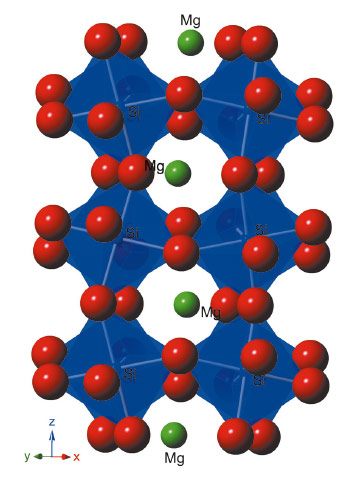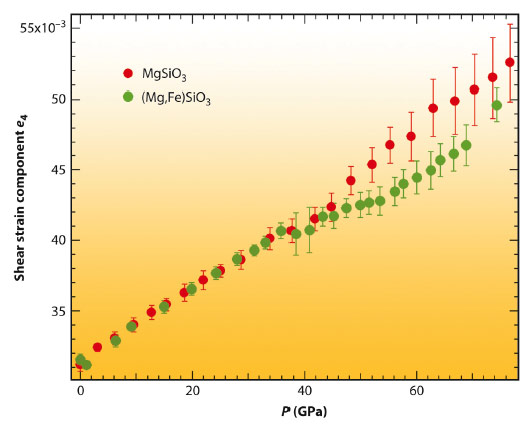- Home
- Users & Science
- Scientific Documentation
- ESRF Highlights
- ESRF Highlights 2012
- Dynamics and extreme conditions
- Single-crystal study of silicate perovskites at conditions of the Earth’s lower mantle
Single-crystal study of silicate perovskites at conditions of the Earth’s lower mantle
High-pressure experiments have shown that at the top of the lower mantle (above 20 GPa or 660 km depth) (Mg,Fe)2SiO4 ringwoodite and majoritic garnet, with a composition between (Mg,Fe,Ca)3Al2SiO12 and (Mg,Fe)4Si4O12, transform to an assemblage of Al and Fe-bearing MgSiO3-perovskite and (Mg,Fe)O ferropericlase [1]. In spite of its simple mineral composition, measurements of seismic wave velocities reveal a complex structure of the Earth’s lower mantle. For example, a number of studies have identified seismic velocity anomalies (called large low-shear velocity provinces) extending from the base to the middle of the lower mantle. Such anomalies are likely to have a chemical origin suggesting that these regions contain a silicate perovskite with a composition distinct from that of the surrounding mantle. An understanding of the plausible chemical variation of perovskite in addition to its effect on density and elastic properties is, therefore, seminal for constraining geophysical models.
MgSiO3 perovskite is orthorhombic, space group Pbnm, and consists of a framework of tilted SiO6 octahedra with Mg occupying the larger dodecahedral sites (Figure 33). Mg can be substituted by Fe2+, whereas Mg and Si can be replaced by Fe3+ and Al usually as coupled substitution.
 |
|
Fig. 33: Room pressure structure of MgSiO3 perovskite viewed down the [110] direction. The distortion of the octahedral framework increases with pressure. |
Three different magnesium silicate perovskite samples, one with compositions of the pure end-member MgSiO3, one containing 4 mole% of Fe2+ substitution [(Mg,Fe)SiO3] (as expected for a peridotitic sample), and one with 37 mole% of Fe3+- Al substitution [(Mg,Fe)(Al,Si)SiO3] (as expected for a perovskite formed within subducted oceanic crust in the lower mantle) have been synthesised using a multi-anvil press and accurately characterised.
We have used the novel setup at beamline ID09A that allows data to be collected from a single crystal of any material at extreme conditions. The use of a single-crystal instead of powdered material has the advantage of providing very high-quality data since deviatoric stresses due to grain-grain interactions are absent. As a result, one can obtain very accurate and precise unit-cell lattice parameters and thus better constrain the compressibility behaviour of the material investigated.
The perovskite single-crystals were loaded in membrane-driven diamond anvil cells with He as the pressure-transmitting medium. Diffraction intensities were collected up to 75 GPa. No significant broadening of the diffraction spots was observed suggesting that the crystals were not subjected to large non-hydrostatic stresses. The high quality of the collected data allows a detailed examination of the effect of the two different chemical substitutions on the compression mechanism of MgSiO3 perovskite, and on the density and seismic velocities at depths of the Earth’s lower mantle.
Since a high-spin to low-spin transition at high-pressure had been observed in ferropericlase, there has been an intense debate about whether such a transition also occurs in Fe substituting into the MgSiO3-perovskite structure. Opinion is still divided, especially because powder data collected for MgSiO3 perovskite with different amounts of Fe lack the necessary resolution to observe such a transition. We were able to observe a clear difference in the variation of the lattice strain (calculated from the measured unit-cell lattice parameters) between MgSiO3 and (Mg,Fe)SiO3 perovskites above 40 GPa for the first time (Figure 34). Such a tiny effect can probably only be detected in very high-quality data, and it supports the suggestion of an intermediate spin state of Fe2+ in perovskite at lower mantle conditions.
 |
|
Fig. 34: Variation with pressure of the shear strain component, e4 (as defined for orthorhombic perovskite in [2]) for MgSiO3 (open circles) and (Mg,Fe)SiO3 (filled circles) perovskites. Above 40 GPa there is a clear difference between the behaviour of the two samples as a result of a possible spin transition of Fe2+. |
The coupled substitution of Fe3+ and Al into the MgSiO3-perovskite structure gives rise to a major change in the compression behaviour of this material. The unit-cell c-axis becomes much more compressible than that of the MgSiO3 end-member, as a result of an initial larger compression of the octahedral site due to the substitution of Si by Al. As a consequence, (Mg,Fe)(Si,Al)O3 perovskite is more compressible than the MgSiO3 end-member.
The two types of substitutions also affect the elastic properties of MgSiO3 perovskite differently. Fe2+ has a large negative effect on the bulk sound velocity and a large increase in density in contrast with Fe3+-Al which have a very modest effect both on the bulk sound velocity and on density. Therefore, of the two, the latter would be the most probable cause of the observed seismic anomalies in the lower mantle.
Principal publication and authors
T. Boffa Ballaran (a), A. Kurnosov (a), K. Glazyrin (a,b), D.J. Frost (a), M. Merlini (c,d), M. Hanfland (d) and R. Caracas (e), Earth and Planetary Science Letters 333–334, 181–190 (2012).
(a) Bayerisches Geoinstitut, Universität Bayreuth (Germany)
(b) Present address: Kline Geoscience Lab., Yale University (USA)
(c) Dipartimento di Scienze della Terra, Università degli Studi di Milano (Italy)
(d) ESRF
(e) CNRS, Ecole Normale Supérieure de Lyon, Laboratoire de Sciences de la Terre (France)
References
[1] T. Irifune, Nature, 370, 131-133 (1994).
[2] M.A. Carpenter, C.J. Howard, K.S. Knight and Z. Zhang, J. Phys. Condens. Matter 18, 10725-10749 (2006).



